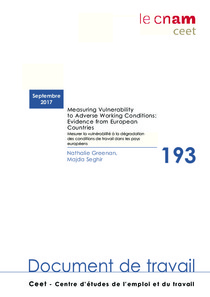Measuring vulnerability to adverse working conditions: evidence from European countries
"Workforce vulnerability has recently come to the forefront in European policy debate as countries searched for the potential engine of inclusive growth with an aim of protecting workers against adverse working conditions. This paper presents a methodology to measure vulnerability at the workpl...
| Main Authors: | , |
|---|---|
| Institution: | ETUI-European Trade Union Institute |
| Format: | TEXT |
| Language: | French |
| Published: |
Noisy-le-Grand
2017
CEET |
| Subjects: | |
| Online Access: | https://www.labourline.org/KENTIKA-19394294124911124769-Measuring-vulnerability-to-adv.htm |
| Summary: | "Workforce vulnerability has recently come to the forefront in European policy debate as countries searched for the potential engine of inclusive growth with an aim of protecting workers against adverse working conditions. This paper presents a methodology to measure vulnerability at the workplace relying on a definition of vulnerable workers as carrying the burden of working under the threat of adverse physical and psychosocial working conditions. Vulnerability is thus a forwardlooking concept that allows identifying workers that are the most exposed to work resource deprivations and more generally to ill-being at the workplace. Using a pseudo-panel derived from repeated cross-sectional data, second-order moments can be used to identify and estimate the variance of shocks on working conditions and, therefore, the probability of being exposed to adverse working conditions in the future. Estimates from the last editions of the European Working Conditions Survey (EWCS) provide a vulnerability measure both at the cohort level and at the aggregate one allowing for comparisons across European countries." |
|---|---|
| Physical Description: | 36 p. Digital |

